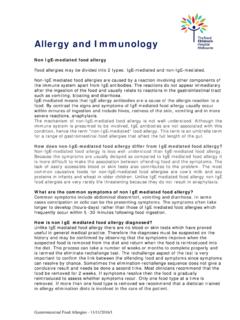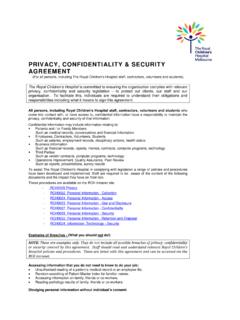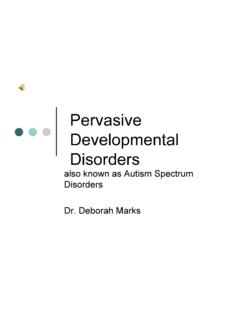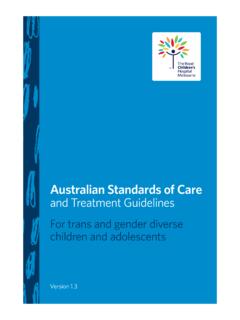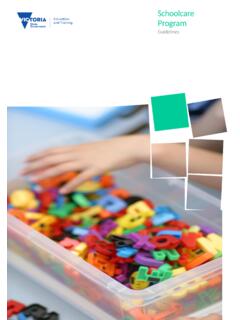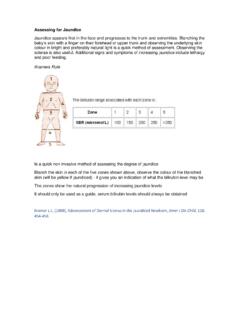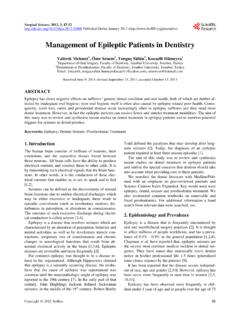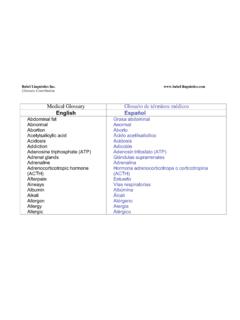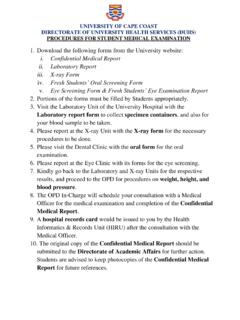Transcription of Saliva Control in Children - Royal Children's Hospital
1 Saliva Control in ChildrenAn information guide forfamilies and cliniciansThis book was written by staff from:Neurodevelopment and Disability and Maxillofacial Surgery Pathology ..1 How is Saliva produced? ..2 What are the major functions of Saliva ? ..4 Why do some Children drool? ..5 How is drooling assessed? ..6 How is drooling managed? ..7 Conservative management ..8 Oral appliances ..18 Medications ..19 Botulinum toxin injections ..21 Surgical management ..24 What to do when drooling cannot be controlled ..25In conclusion ..26 IntroductionDrooling (also known as poor Saliva Control , sialorrhoea or dribbling ) is sometimes a problem in Children and adolescents with cerebral palsy, intellectual disability and other neurological impairments.
2 The incidence of drooling has been found to be as high as 40% in young people with cerebral palsy. In addition to the social implications for Children and families, excessive drooling can cause skin irritation and require frequent changes of clothes and bibs. We have written this booklet to answer some of your questions and to provide information about assessment and management of drooling. 1 How is Saliva produced? There are three major pairs of glands in the mouth, the submandibular, sublingual and parotid glands . It is estimated that 500 to 2000 ml of Saliva is produced per day .The submandibular and sublingual glands produce Saliva through ducts in the front of the mouth just under the tongue (see Figure 1) . The submandibular glands produce most (about 65%) of the Saliva in the mouth and their secretions are watery.
3 The sublingual glands produce a little Saliva that is thick and mucousy . The parotid glands produce Saliva through ducts which open into the mouth near the second upper molar teeth . These large glands are most active during meal times .The autonomic nervous system involving both parasympathetic and sympathetic nervous systems is responsible for the overall Control of salivation . These nerves are not under conscious Control .ParotidglandSubmandibularglandSublingua lglandFigure 1. Location of the major salivary glands with ducts shown as arrows23 Blowing bubbles. This may help to develop oral awareness (see page 9) 23 What are the major functions of Saliva ? Lubricates food to assist with chewing and turns food into a bolus (soft ball) for ease of swallowing Lubricates the tongue and lips during speech Cleanses the teeth and gums and assists with oral hygiene Regulates acidity in the oesophagus (gullet) Destroys micro-organisms and clears toxic substances Facilitates taste Initiates carbohydrate digestion454 Why do some Children drool?
4 Drooling can be a normal occurrence in the first six to eighteen months of life until oral-motor function is developed . It is considered abnormal for a child older than four years to exhibit persistent drooling and this problem is most commonly seen in cerebral palsy or other conditions with severe neurological impairment . There is a small group of able-bodied Children who drool up to about the age of six years .Drooling is not normally a result of overproduction but inefficient Control of salivary secretions . This may be due to: lack of awareness of external salivary loss Inadequate lip closure resulting in an open mouth posture Absent or impaired oropharyngeal (mouth and back of throat) sensation Abnormal movements/abnormal tone of the tongue and lips (sometimes known as intra-oral motor impairment) Reduced frequency of swallowing and difficulty with swallowing (sometimes known as dysphagia) A combination of these factors.
5 There may be other contributory factors: Poor posture (impaired head and/or trunk Control ) dental problems such as dental caries and malocclusion Mouthing of objects Medication being used for other purposes, for example, clonazepam (Rivotril) for epilepsy .Good-quality scarves / cravats may help absorption of secretions455 How is drooling assessed?A multidisciplinary approach is helpful . An attempt is made to determine which of the factors listed above may be contributory . For example, does the child have an open mouth posture, or abnormal movements of the tongue and lips? Questions are asked about:1 . General health drooling often becomes more profuse and problematic when Children have recurrent upper respiratory infections or nasal obstruction2 . Medications knowing about drugs being taken can help to determine if they are contributing to the problem3.
6 dental history poor dental care and cavities are often associated with drooling4 . Eating and drinking as poor Saliva Control is frequently accompanied by problems with chewing and difficulties with swallowing5 . Communication abilities some Children do not have oral speech because of severe oral motor difficulties . These Children often have eating and drinking problems and also drool .measuring drooling severity and frequencyThe severity and frequency of drooling is often measured using the five-point drooling severity score and the four point drooling frequency score (see Figure 2) .Figure 2. Thomas-Stonell and Greenberg scaleDrooling severityDrooling frequency1 Dry1 Never2 Mild wet lips2 Occasionally3 Moderate wet lips and chin3 Frequently4 Severe clothing damp4 Constantly5 Profuse clothing, hands and objects wet67saliva management clinicsSpecialised clinics for Saliva management exist in some centres.
7 The Saliva Control Clinic at The Royal Children s Hospital , Melbourne is a multi-disciplinary clinic with a speech pathologist, a paediatric dentist, paediatrician, plastic surgeon and nurse coordinator .Information is gathered by having the family complete a questionnaire prior to their appointment . At the clinic, a history of the Saliva Control problem is taken, the Children are observed and an assessment of drooling is made by carers and clinicians using the drooling frequency and severity scores described on page 6 . Recommendations are made at the conclusion of the clinic visit that may include further management by a local speech pathologist, referral for dental treatment, consultation with an ear, nose and throat specialist, or as detailed on the following pages, conservative measures, the use of medication, a trial of an oral appliance or a recommendation for surgery.
8 How is drooling managed?There are five approaches:1. Conservative management2. Oral appliances3. Medication including oral medications, oral drops and dermal patches4. Botulinum toxin injections5. Surgical managementGirl inserting oral screen, with the aim of encouraging lip sealOral screen67 Conservative management Management of underlying problems Helping Children be more aware of Saliva and oral movements Eliminating mouthing behaviours Encouraging Children to swallow more, and wipe their face Improving and maintaining oral healthmanagement of underlying problemsIt may be possible to address underlying problems that may be aggravating drooling, for example, the presence of nasal obstruction, dental disease or the use of medication that may be contributing to the problem.
9 Physiotherapy or occupational therapy may be helpful in improving posture and seating, for example, wheelchair modifications may facilitate better head Control . Repositioning the computer screen and input device (keyboard or switch) may also be helpful in achieving improved posture .helping Children be more aware of Saliva and oral movementsWhen we get enough Saliva in our mouths we swallow it automatically and thus we do not drool . This does not seem to happen in Children who drool . Some Children seem very unaware of what is in and around their mouths and can also be messy eaters, getting food around their lips, cheeks and chin . Many Children seem not to notice the Saliva escaping the mouth until it is too late to retrieve it . Developing eating skillsDeveloping eating skills specifically related to Saliva Control can be helpful.
10 This includes developing lip Control by increasing the length of time that Children can maintain lip closure and developing lateral tongue movements in chewing . This is encouraged by the placement of different food textures, graded from easy to chew to more difficult to chew, between the molars . Building up the child s awareness of Saliva both inside and outside of the mouth is very helpful . Behavioural approaches and techniques to help the child be more aware of Saliva and oral movements can reinforce each other . The behavioural approach involves teaching the child to recognise the feeling of wetness and be able to either swallow more frequently or wipe the Saliva from the lips and chin .89 Exercises and gamesMany Children have lips that are incapable of making a firm seal.
